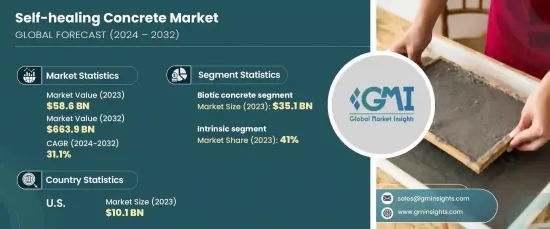PUBLISHER: Global Market Insights Inc. | PRODUCT CODE: 1666948

PUBLISHER: Global Market Insights Inc. | PRODUCT CODE: 1666948
Self-Healing Concrete Market Opportunity, Growth Drivers, Industry Trend Analysis, and Forecast 2024 - 2032
The Global Self-Healing Concrete Market reached an impressive valuation of USD 58.6 billion in 2024 and is set to soar at a remarkable CAGR of 31.1% between 2025 and 2034. Although initial challenges such as supply chain disruptions, labor shortages, and construction delays slowed momentum, the industry's strong recovery and a focus on innovation have revitalized its growth trajectory.

The growing emphasis on sustainable and durable construction practices is a driving force behind the rising demand for self-healing concrete. By addressing common problems such as cracks and structural degradation, this advanced material not only extends infrastructure lifespans but also reduces maintenance costs. As eco-friendly solutions and resilient infrastructure take center stage globally, self-healing concrete has become a cornerstone of modern construction projects.
| Market Scope | |
|---|---|
| Start Year | 2023 |
| Forecast Year | 2024-2032 |
| Start Value | $58.6 Billion |
| Forecast Value | $663.9 Billion |
| CAGR | 31.1% |
The market is segmented by concrete type into biotic and abiotic variants. In 2024, the biotic concrete segment led the market, accounting for USD 35.1 billion, and is projected to grow at a CAGR of 30.6% through 2034. Biotic concrete, enriched with biological agents, is gaining traction due to its environmental benefits. This innovative material supports green building initiatives and sustainability goals by offering self-healing capabilities and improved air quality. Its adoption in urban infrastructure and eco-conscious architectural projects underscores its growing significance.
The market is further categorized by form into intrinsic, capsule-based, and vascular self-healing concrete. The intrinsic segment, comprising 41% of the market share in 2024, is anticipated to grow at a robust CAGR of 31.7% between 2025 and 2034. Known for its ability to naturally heal micro-cracks without external intervention, intrinsic concrete is prized for its durability and cost-saving benefits.
The vascular segment, on the other hand, is expected to grow at a CAGR of 30.7%, driven by its ability to deliver targeted, efficient crack repair solutions, further enhancing its appeal for specialized applications.
In the United States, the self-healing concrete market was valued at USD 10.1 billion in 2024 and is set for significant growth at a CAGR of 31% through 2034. The surge in federal and state infrastructure investments has been a key growth factor. Substantial funding is being allocated to modernizing roads, bridges, and water systems, creating a robust demand for advanced materials like self-healing concrete. Its promise of durability, cost efficiency, and environmental benefits makes it an ideal choice for transforming aging infrastructure.
Table of Contents
Chapter 1 Methodology & Scope
- 1.1 Market scope & definitions
- 1.2 Base estimates & calculations
- 1.3 Forecast calculations
- 1.4 Data sources
- 1.4.1 Primary
- 1.4.2 Secondary
- 1.4.2.1 Paid sources
- 1.4.2.2 Public sources
Chapter 2 Executive Summary
- 2.1 Industry synopsis, 2021-2032
Chapter 3 Industry Insights
- 3.1 Industry ecosystem analysis
- 3.1.1 Factor affecting the value chain
- 3.1.2 Profit margin analysis
- 3.1.3 Disruptions
- 3.1.4 Future outlook
- 3.1.5 Manufacturers
- 3.1.6 Distributors
- 3.2 Supplier landscape
- 3.3 Profit margin analysis
- 3.4 Key news & initiatives
- 3.5 Regulatory landscape
- 3.6 Impact forces
- 3.6.1 Growth drivers
- 3.6.1.1 Increasing demand for durable and sustainable infrastructure
- 3.6.1.2 Advancements in self-healing technologies and materials
- 3.6.1.3 Rising investments in smart cities and green construction
- 3.6.2 Industry pitfalls & challenges
- 3.6.2.1 High initial costs of self-healing concrete solutions
- 3.6.2.2 Limited awareness and adoption in emerging markets
- 3.6.1 Growth drivers
- 3.7 Growth potential analysis
- 3.8 Porter’s analysis
- 3.9 PESTEL analysis
Chapter 4 Competitive Landscape, 2023
- 4.1 Introduction
- 4.2 Company market share analysis
- 4.3 Competitive positioning matrix
- 4.4 Strategic outlook matrix
Chapter 5 Market Estimates & Forecast, By Concrete Type, 2021-2032 (USD Billion) (Kilo Tons)
- 5.1 Key trends
- 5.2 Biotic concrete
- 5.3 Abiotic concrete
Chapter 6 Market Estimates & Forecast, By Form, 2021-2032 (USD Billion) (Kilo Tons)
- 6.1 Key trends
- 6.2 Intrinsic
- 6.3 Capsule based
- 6.4 Vascular
Chapter 7 Market Estimates & Forecast, By Application, 2021-2032 (USD Billion) (Kilo Tons)
- 7.1 Key trends
- 7.2 Residential construction
- 7.3 Commercial construction
- 7.4 Infrastructure
- 7.5 Industrial construction
Chapter 8 Market Estimates & Forecast, By Distribution Channel, 2021-2032 (USD Billion) (Kilo Tons)
- 8.1 Key trends
- 8.2 Online
- 8.3 Offline
Chapter 9 Market Estimates & Forecast, By Region, 2021-2032 (USD Billion) (Kilo Tons)
- 9.1 Key trends
- 9.2 North America
- 9.2.1 U.S.
- 9.2.2 Canada
- 9.3 Europe
- 9.3.1 UK
- 9.3.2 Germany
- 9.3.3 France
- 9.3.4 Italy
- 9.3.5 Spain
- 9.4 Asia Pacific
- 9.4.1 China
- 9.4.2 Japan
- 9.4.3 India
- 9.4.4 South Korea
- 9.4.5 Australia
- 9.4.6 Malaysia
- 9.4.7 Indonesia
- 9.5 Latin America
- 9.5.1 Brazil
- 9.5.2 Mexico
- 9.6 MEA
- 9.6.1 UAE
- 9.6.2 Saudi Arabia
- 9.6.3 South Africa
Chapter 10 Company Profiles
- 10.1 Acciona Infraestructuras S.A.
- 10.2 Akzo Nobel N.V.
- 10.3 Avecom N.V.
- 10.4 Basilisk
- 10.5 Buzzi Unicem USA
- 10.6 CEMEX S.A.B. de C.V.
- 10.7 Corbion
- 10.8 GCP Applied Technologies Inc.
- 10.9 Giatec Scientific Inc.
- 10.10 Green-Basilisk BV
- 10.11 Kryton International Inc.
- 10.12 MBCC Group
- 10.13 Oscrete Construction Products
- 10.14 Sika AG
- 10.15 Xypex Chemical Corporation




